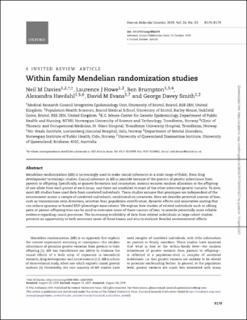| dc.contributor.author | Davies, Neil M. | |
| dc.contributor.author | Howe, Laurence | |
| dc.contributor.author | Brumpton, Ben Michael | |
| dc.contributor.author | Havdahl, Alexandra | |
| dc.contributor.author | Evans, David M. | |
| dc.contributor.author | Smith, George Davey | |
| dc.date.accessioned | 2021-04-16T12:07:09Z | |
| dc.date.available | 2021-04-16T12:07:09Z | |
| dc.date.created | 2019-12-05T13:25:24Z | |
| dc.date.issued | 2019 | |
| dc.identifier.citation | Human Molecular Genetics. 2019, 28 (2), R170-R179. | en_US |
| dc.identifier.issn | 0964-6906 | |
| dc.identifier.uri | https://hdl.handle.net/11250/2738147 | |
| dc.description.abstract | Mendelian randomization (MR) is increasingly used to make causal inferences in a wide range of fields, from drug development to etiologic studies. Causal inference in MR is possible because of the process of genetic inheritance from parents to offspring. Specifically, at gamete formation and conception, meiosis ensures random allocation to the offspring of one allele from each parent at each locus, and these are unrelated to most of the other inherited genetic variants. To date, most MR studies have used data from unrelated individuals. These studies assume that genotypes are independent of the environment across a sample of unrelated individuals, conditional on covariates. Here we describe potential sources of bias, such as transmission ratio distortion, selection bias, population stratification, dynastic effects and assortative mating that can induce spurious or biased SNP–phenotype associations. We explain how studies of related individuals such as sibling pairs or parent–offspring trios can be used to overcome some of these sources of bias, to provide potentially more reliable evidence regarding causal processes. The increasing availability of data from related individuals in large cohort studies presents an opportunity to both overcome some of these biases and also to evaluate familial environmental effects. | en_US |
| dc.language.iso | eng | en_US |
| dc.publisher | Oxford University Press | en_US |
| dc.title | Within family Mendelian randomization studies | en_US |
| dc.type | Peer reviewed | en_US |
| dc.type | Journal article | en_US |
| dc.description.version | publishedVersion | en_US |
| dc.source.pagenumber | R170-R179 | en_US |
| dc.source.volume | 28 | en_US |
| dc.source.journal | Human Molecular Genetics | en_US |
| dc.source.issue | 2 | en_US |
| dc.identifier.doi | 10.1093/hmg/ddz204 | |
| dc.identifier.cristin | 1757173 | |
| dc.relation.project | Helse Sør-Øst RHF: 2018059 | en_US |
| dc.relation.project | Stiftelsen Kristian Gerhard Jebsen: SKGJ-MED-015 | en_US |
| dc.description.localcode | This article is published and distributed under the terms of the Oxford University Press, Standard Journals Publication Model (https://academic.oup.com/journals/pages/open_access/funder_policies/chorus/standard_publication_model) | en_US |
| cristin.ispublished | true | |
| cristin.fulltext | original | |
| cristin.qualitycode | 2 | |
